Regulators of mitonuclear balance link mitochondrial metabolism to mtDNA expression
- PMID: 37770567
- PMCID: PMC11370000
- DOI: 10.1038/s41556-023-01244-3
Regulators of mitonuclear balance link mitochondrial metabolism to mtDNA expression
Abstract
Mitochondrial oxidative phosphorylation (OXPHOS) complexes are assembled from proteins encoded by both nuclear and mitochondrial DNA. These dual-origin enzymes pose a complex gene regulatory challenge for cells requiring coordinated gene expression across organelles. To identify genes involved in dual-origin protein complex synthesis, we performed fluorescence-activated cell-sorting-based genome-wide screens analysing mutant cells with unbalanced levels of mitochondrial- and nuclear-encoded subunits of Complex IV. We identified genes involved in OXPHOS biogenesis, including two uncharacterized genes: PREPL and NME6. We found that PREPL specifically impacts Complex IV biogenesis by acting at the intersection of mitochondrial lipid metabolism and protein synthesis, whereas NME6, an uncharacterized nucleoside diphosphate kinase, controls OXPHOS biogenesis through multiple mechanisms reliant on its NDPK domain. Firstly, NME6 forms a complex with RCC1L, which together perform nucleoside diphosphate kinase activity to maintain local mitochondrial pyrimidine triphosphate levels essential for mitochondrial RNA abundance. Secondly, NME6 modulates the activity of mitoribosome regulatory complexes, altering mitoribosome assembly and mitochondrial RNA pseudouridylation. Taken together, we propose that NME6 acts as a link between compartmentalized mitochondrial metabolites and mitochondrial gene expression.
© 2023. The Author(s), under exclusive licence to Springer Nature Limited.
Figures
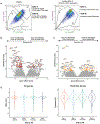

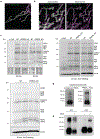


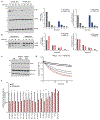
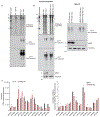
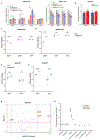
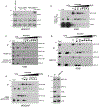
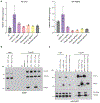

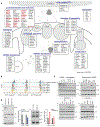
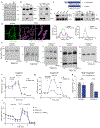

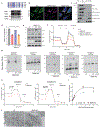
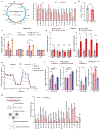
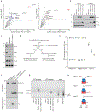

Update of
-
Genome-wide screens for mitonuclear co-regulators uncover links between compartmentalized metabolism and mitochondrial gene expression.bioRxiv [Preprint]. 2023 Feb 11:2023.02.11.528118. doi: 10.1101/2023.02.11.528118. bioRxiv. 2023. Update in: Nat Cell Biol. 2023 Nov;25(11):1575-1589. doi: 10.1038/s41556-023-01244-3. PMID: 36798306 Free PMC article. Updated. Preprint.
Similar articles
-
Mitochondrial NME6: A Paradigm Change within the NME/NDP Kinase Protein Family?Cells. 2024 Jul 30;13(15):1278. doi: 10.3390/cells13151278. Cells. 2024. PMID: 39120309 Free PMC article. Review.
-
Genome-wide screens for mitonuclear co-regulators uncover links between compartmentalized metabolism and mitochondrial gene expression.bioRxiv [Preprint]. 2023 Feb 11:2023.02.11.528118. doi: 10.1101/2023.02.11.528118. bioRxiv. 2023. Update in: Nat Cell Biol. 2023 Nov;25(11):1575-1589. doi: 10.1038/s41556-023-01244-3. PMID: 36798306 Free PMC article. Updated. Preprint.
-
Mitochondrial double-stranded RNA homeostasis depends on cell-cycle progression.Life Sci Alliance. 2024 Aug 29;7(11):e202402764. doi: 10.26508/lsa.202402764. Print 2024 Nov. Life Sci Alliance. 2024. PMID: 39209534 Free PMC article.
-
NME6 is a phosphotransfer-inactive, monomeric NME/NDPK family member and functions in complexes at the interface of mitochondrial inner membrane and matrix.Cell Biosci. 2021 Nov 17;11(1):195. doi: 10.1186/s13578-021-00707-0. Cell Biosci. 2021. PMID: 34789336 Free PMC article.
-
Coordinating mitochondrial translation with assembly of the OXPHOS complexes.Hum Mol Genet. 2024 May 22;33(R1):R47-R52. doi: 10.1093/hmg/ddae025. Hum Mol Genet. 2024. PMID: 38779773 Free PMC article. Review.
Cited by
-
Navigating the landscape of mitochondrial-ER communication in health and disease.Front Mol Biosci. 2024 Jan 23;11:1356500. doi: 10.3389/fmolb.2024.1356500. eCollection 2024. Front Mol Biosci. 2024. PMID: 38323074 Free PMC article. Review.
-
Transcriptomic analysis identifies muscle-specific mitochondrial and vesicular transport genes as methylmercury toxicity targets in a Drosophila model of congenital Minamata disease.Toxicol Sci. 2025 May 1;205(1):106-123. doi: 10.1093/toxsci/kfaf018. Toxicol Sci. 2025. PMID: 39951334
-
Mitochondrial NME6: A Paradigm Change within the NME/NDP Kinase Protein Family?Cells. 2024 Jul 30;13(15):1278. doi: 10.3390/cells13151278. Cells. 2024. PMID: 39120309 Free PMC article. Review.
-
Mitochondrial NME6 Influences Basic Cellular Processes in Tumor Cells In Vitro.Int J Mol Sci. 2024 Sep 4;25(17):9580. doi: 10.3390/ijms25179580. Int J Mol Sci. 2024. PMID: 39273527 Free PMC article.
-
WBSCR16 is essential for mitochondrial 16S rRNA processing in mammals.Nucleic Acids Res. 2025 Jan 24;53(3):gkae1325. doi: 10.1093/nar/gkae1325. Nucleic Acids Res. 2025. PMID: 39878214 Free PMC article.
References
-
- Ryan MT & Hoogenraad NJ Mitochondrial-nuclear communications. Annu. Rev. Biochem 76, 701–722 (2007). - PubMed
-
- Mottis A, Herzig S & Auwerx J Mitocellular communication: Shaping health and disease. Science 366, 827–832 (2019). - PubMed
-
- Isaac RS, McShane E & Churchman LS The Multiple Levels of Mitonuclear Coregulation. Annu. Rev. Genet 52, 511–533 (2018). - PubMed
-
- Chan DC Mitochondria: dynamic organelles in disease, aging, and development. Cell 125, 1241–1252 (2006). - PubMed
Publication types
MeSH terms
Substances
Grants and funding
LinkOut - more resources
Full Text Sources
Molecular Biology Databases
Research Materials

